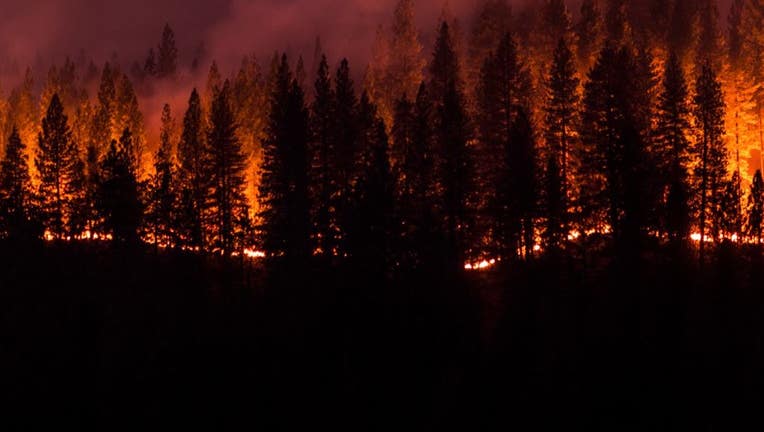Bracing for the heat: Cal Fire awards $72 million in prevention grants

OAKLAND, Calif. - Climate change has made California's wildfire season a year-round threat — two of the most destructive fires in the state's history happened earlier this year, in the dead of winter.
Now approaching the hottest, driest months of the year, state agencies are working to minimize the chances of another conflagration.
Spreading resources
By the numbers:
The California Department of Forestry and Fire Protection, Cal Fire, on Friday announced it would be awarding $72 million to projects that are working to reduce wildfire risks. The money comes less than a month after President Trump announced plans to cut the U.S. Forest Service, the agency that manages 193 million acres of national forests and grasslands across the country. Around 75% of agency personnel are trained in wildland firefighting.
"Cal Fire is proud to award Forest Health grants that will increase the wildfire resilience of California's landscapes and communities and help restore ecosystems following wildfire," Alan Talhelm, Assistant Deputy Director of Climate and Energy at Cal Fire said in a press release. "These grants will provide our partners around the state with funds to complete projects that support local economies, protect watersheds, increase public safety and sequester carbon."
Cal Fire's Forest Health grants are funded through the Timber Regulation and Forest Restoration Fund, with additional funds provided by California Climate Investments, a state initiative that directs money toward achieving the state's climate goals.
The funded projects focus on large-scale projects that cover at least 800 acres of land.
Governor Gavin Newsom also recently announced that the state had fast-tracked approval for 13 projects that cover nearly 7,000 acres, in addition to the nearly 2 million acres treated in recent years.
Collaborators
Big picture view:
Around 40% of California's forests sit on privately owned land, while the state manages only 3%. The remaining 57% is overseen by the federal government. The mix of oversight requires collaboration between stakeholders to mitigate the risk of wildfire; Cal Fire estimates that 83% of all tree mortality in the state, which poses a significant wildfire risk, is on national forest lands.
The collaborative relationship is getting strained, though.
President Trump announced earlier this year that he would be cutting 10% of Forest Service staff, or 3,400 employees, came as a blow to the state's fire-prevention efforts. The impacts were felt by employees on the ground and at the leadership level — Biden-era Chief Randy Moore announced his retirement in February, in response to the staffing cuts. More than half of the agency's department heads followed his example and also left the Forest Service.
The president has announced a plan to reduce California's risk of wildfire: logging. His administration in April released a memo that designated 112,646,000, or 59% of all national forest lands, as a priority for logging. The document cited wildfire risk, declining forest health and the risk of increased tree mortality as some of the reasons for logging the land.
Boots on the ground
Dig deeper:
Cal Fire is funding projects including:
- The Upper Mokelumne River Watershed Authority's fuels reduction efforts on 1,288 acres in the El Dorado National Forest.
- The Redwood Forest Foundation's plans to treat 867 acres of forest fuel in a rural, low-income area in Northern Mendocieno County. The project will create over 80 forestry jobs, as well as additional positions for you adults via California Conservation Corps trail work.
The projects Newsom has fast-tracked include:
- The Prosper Ridge Community Wildfire Resilience Project in Humboldt County, a collaboration between federal, state and tribal agencies that will treat nearly 450 acres with mechanical thinning, manual treatments, and prescribed fire.
- The Tonner Canyon South Vegetation Management Project, which aims to protect 354 acres south of Diamond Bar in Los Angeles County by removing hazardous vegetation, creating fuel breaks and improving defensible space.
- The Scott Valley/Callahan Fuels Reduction and Forest Resiliency Project, which is located on 2,917 acres in the Scott River watershed is Siskiyou County, which will work to increase the health of stands of timber for improved carbon capture, fire resiliency, and tree health.
- The Weed Community Fire Restoration and Enhancement Project, which focuses on protecting 1,923 acres near the city of Weed in Siskiyou County and providing safe ingress and egress to emergency responders.
- The Sycuan Wildfire Resiliency Project, which covers over 240 acres in San Diego, and aims to protect the Sycuan reservation by reducing fire hazard, ensuring defensible space, and providing safe egress, through the use of 300 grazing goats.

